Bride of Chaotica! is an enjoyable mess.
As its title implies, Bride of Chaotica! is a celebration of nostalgic futurism. It is a culmination of a number of themes running through the series. Most obviously, this particular brand of retrofuturism has been a recurring gag since Night at the start of the fifth season, but it fits within a broader context. From the outset, Star Trek: Voyager has been engaged with a more nostalgic sci-fi aesthetic than Star Trek: The Next Generation or Star Trek: Deep Space Nine.

Bride of evil.
Voyager‘s retrofuturism has taken various forms; the old school “space western” tone established by Caretaker, the retro sci-fi trappings of episodes like Innocence or Rise, the monster mayhem of episodes like Phage or Macrocosm, the Cold War paranoia of Cathexis or In the Flesh, Tom Paris’ nostalgic holoprograms in Lifesigns or Vis á Vis, the abductees from the early twentieth century in The 37’s. However, perhaps the most basic is baked into the concept of the show. Voyager is literally a series about the desire to return to a safer and more familiar time.
In some ways, Bride of Chaotica! cements this nostalgia in the context of the larger Star Trek canon, embracing the anxiety that has become increasingly apparent in the years since the thirtieth anniversary. After all, the surrounding feature films all literalise the pull of the past. Star Trek: First Contact has Jean-Luc Picard literally journey back to twenty-first century Earth while revisiting his most iconic moment. Star Trek: Insurrection has the crew discover the fountain of youth. Star Trek: Nemesis confronts Picard with a younger clone of himself.

Radio Chaotica!
It is perhaps telling that Voyager was the moment at which the Star Trek franchise stopped pushing forward. During and after Voyager, the franchise would become increasingly backwards-looking. Star Trek: Enterprise would invite the audience to meet James T. Kirk’s childhood era, trying to recapture that old magic. JJ Abrams’ Star Trek reboot would focus on a young version of Kirk and Spock. Star Trek: Discovery will feature a central character who is something close to Spock’s sister. There is a conscious pull of nostalgia.
Perhaps the future was better yesterday.

Never too far afield.
Bride of Chaotica! is mostly great fun. It is an episode that exploits the potential of the holodeck as a twenty-fourth century role-playing television set. It is a device that serves a number of storytelling purposes. Most literally, it allows the characters to step outside the universe of Star Trek and into another genre, as they do in episodes like QPid or Badda-Bing, Badda-Bang. However, it is also a nice gateway into more postmodern meditations upon genre and storytelling, as in Ship in a Bottle or Our Man Bashir.
Bride of Chaotica! is built in such a way that it serves both purposes. It is very obvious an excuse for the cast and crew to play dress-up, to revel in the tropes and conventions of pulp science-fiction storytelling. Watching Bride of Chaotica!, it is clear that everybody working on the show had a fantastic time. The edits are done in the style of retro adventure serials, villains crack the microphone wire like a whip, the soundtrack has decidedly retro vibe to it, the production is consciously designed to look shoddy down to the clothe jumpsuits worn by Chaotica’s soldiers.
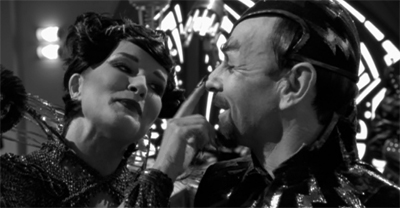
“I nose what I’m doing.”
The cast have great fun with the material. As Kate Mulgrew confessed to Starlog:
“Bride of Chaotica! was a blast, a blast,” enthuses Mulgrew. “It was a little controversial, but what the hell? It pushed the envelope a little bit, which we must do every now and then. And I loved playing Arachnia.”
Robert Picardo also does good work when the EMH is asked to step into the role of “the President.”

All the President’s holograms.
To be fair, there is something quite clever in the set-up of Bride of Chaotica!, and its use of Kathryn Janeway. Most superficially, the episode provides Kate Mulgrew with a nice opportunity to camp it up. The climax of the episode is a delight, with Mulgrew playing Janeway as a self-aware ham trying to work her way into the graces of the eponymous supervillain. Mulgrew plays the sequence very broad, but it works. It evokes Avery Brooks performance in episodes like Dramatis Personae or Crossover, an actor relishing the opportunity to go big.
While Mulgrew’s performance isn’t as finely honed as her work in Counterpoint, there is still a lot going on. Mulgrew is playing Janeway playing Arachnia, and one of the joys of Bride of Chaotica! is the sense that both Mulgrew and Janeway are allowing themselves to enjoy the experience. When Chaotica invites his beloved to sit on his throne, Janeway takes a small moment to savour it. “Somehow I feel comfortable here,” she reflects with a smirk, stopping just short of winking at the camera. It is meant to be fun, and it is fun.
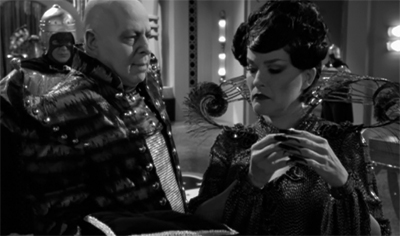
A nice ring to it.
At the same time, there is also the faint suggestion of a small feminist narrative playing out beneath the campy exterior. After all, the Captain Proton! holonovels are clearly a product of their time, hypermasculine power fantasies. The only female character other than Arachnia to appear in Bride of Chaotica! is that of the lead character’s secretary. Constance Goodheart has no lines. Her function is only to scream. Although Paris suggests that she normally survives these stories, she is also ruthlessly fridged early in the story.
Even beyond Bride of Chaotica!, it is clear that the Captain Proton! adventures are designed to evoke a retrograde sensibility. When the Delaney Sisters play “the Twin Mistresses of Evil” in Thirty Days, they are clearly intended to evoke family-friendly bondage. They are that old cliché of Hayes Code sexuality, smouldering in none-too-subtle subtext as they tie Harry Kim up and plan to subject them to their wicked ways. This cliché is still accepted in genre fiction; Lursa and B’Etor play that kinky convention straight in Redemption, Part I and Redemption, Part II.

He’s certainly throne a party.
With that in mind, there is something very cheeky in the way that Janeway intrudes into the Captain Proton! narrative and just owns it. Tom Paris might be playing the protagonist of the holonovel, but he is largely impotent at the climax of the narrative. Janeway takes command of the situation, singlehandedly lowering the “lightning shield” so that the alien forces might storm the citadel. She does this with no back-up, no support, and no real familiarity with the world in which she finds herself.
Indeed, Bride of Chaotica! repeatedly confronts Janeway with the sexist trappings of classic pulpy fiction. Much like Constance Goodheart, she is restrained and tied up by the villains as they turn their attention to the more masculine threat outside. Like so many female characters in these stories, she is subjected to thinly-veiled sexual threats. “Oh, don’t worry, I wouldn’t kill my bride,” Chaotica assures her. “Not until after our wedding night.” At one point, Janeway even suggestively strokes Chaotica’s incredibly phallic “Death Ray.”
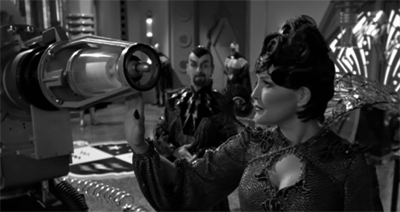
“Oh, it looks like a… formidable weapon. Yes, that’s the right euphemism.”
The implication is clear, Janeway has found herself in a hyper-masculine fantasy world that is not designed to welcome her. In some ways, it reflects Janeway’s position as the first female lead on a Star Trek show, as a female protagonist in a genre that is in some ways still as aggressively masculine as it was during the thirties and forties. However, Bride of Chaotica! makes a point to allow Janeway to transcend all of those hurdles. She does not need Captain Proton to rescue her, she saves herself. Captain Proton does not get to shoot Chaotica, Janeway does.
The biggest problem with all of this is that Janeway only really gets to step into the role of Arachnia in the final ten minutes of the episode. The rest of the episode builds up to the sight of Janeway in costume, playing off the eponymous megalomaniac. However, Janeway is not the focus of the episode up until that point. Her role in the climax is not properly seeded. That final is so good, that it frequently feels like everything leading up to it is just the script treading water.
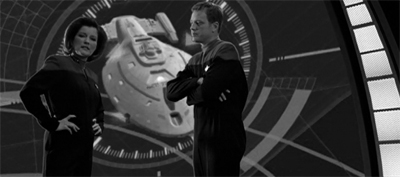
“Seven, is there any way we can work in more technobabble?”
As such, there is a clumsiness to the episode. Like a lot of Voyager episodes, there is a sense that Bride of Chaotica! spends far too much time on set-up before getting to the meat of the story. There is far too much time spent on the familiar sets in a framing story, sequences that take away from the more exciting storytelling beats on the holodeck. It takes the crew too long to figure out they are stuck on “a subspace sandbar” and they spend far too long futilely trying to escape it.
As with other “off-format” episodes like The Swarm, Real Life or Day of Honour, there is a sense that the production team are worried that the audience might not realise that they are watching a science-fiction show, and so the early section of Bride of Chaotica! spends far too much time stalling for time. To be fair, Janeway seems to acknowledge as much in her log, admitting, “We’ve been spinning our wheels for three days now, and still no progress.” To the audience it only feels like three days.

Once again, Janeway’s monomaniacal appetite for coffee puts the entire crew in danger. Again.
These sequences are particularly striking because they are so unnecessary. During the production of Bride of Chaotica!, the bridge sets were severely damaged in a fire. As Robert Duncan McNeill told Cinefantastique:
McNeill remembered, “We’ve been here five years, and there’s some dust that has collected on top of these sets, on the ceilings. There are lights that hang up high and one of the light bulbs popped.”
He laughed, “I guess the spark smoldered down in the dust, and caught fire on the ceiling of the bridge, right during a photo shoot with Rick Berman on the bridge. I don’t know what the connection is, but I am sure there is some meaning behind it. No one was hurt, but we had a hungry crew, and our lunch was on that stage.”
As such, it would have made sense to spend as little time on the bridge as necessary, and to commit wholeheartedly to the story unfolding in the holodeck.
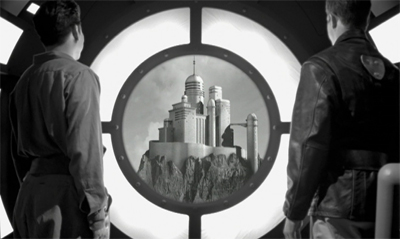
“Last time, on Captain Proton!”
Then again, Voyager would never have been comfortable embracing that sort of narrative experimentation. Bride of Chaotica! co-writer Michael Taylor had originally pitched Once Upon a Time as an episode that would have been told exclusively from the perspective of Naomi Wildman in the holodeck as the crew wrestled with a crisis in the real world. There is a sense that Bride of Chaotica! and Once Upon a Time would have been much stronger episodes if the production team had decided to commit to a more adventurous execution.
In keeping with Voyager‘s interests and tropes, Bride of Chaotica! also employs far too much technobabble for what should be a simple story. Early in the episode, the script spends far too much time accounting for that “subspace sandbar.” There are is a “trans-spectral analysis”, along with “gravimetric forces” and “particle fields.” Interestingly enough, this fetishisation of technology also carries over into the fictional science-fiction world of the Captain Photon! holonovel.
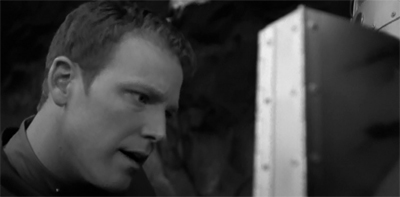
“What if Satan’s Robot re-fuses?”
In the wake of a devastating battle, Paris finds the broken form of Satan’s Robot. “If we can repair his vocaliser he might be able to tell us what’s been going on,” Paris assures Tuvok as he opens the service hatch on the front of the mechanical life form. “It looks like he burned out a resister.” Tuvok is confused. Paris clarifies, “That’s a few centuries before duotronic circuitry.” When Paris removes a little lightbulb and hands it to Tuvok, there is a sense that Bride of Chaotica! somehow finds even fifties science-fiction technobabble to be cute.
Still, there is a lot to like about Bride of Chaotica! Some of the episode’s best gags are actually the low-key ones, jokes that demonstrate a self-awareness that is often absent from the Berman-era shows. Most of the scenes involving Satan’s Robot are hilarious, once it is up and running. The robot very clearly moves like a person in a suit, an exaggerated and clumsy gait. When the photonic aliens appear, the robot panics. “Invaders!” Paris interrupts. “Quiet!” Satan’s Robot obeys, and drops its volume significantly. “Invaders.” It is a good gag.
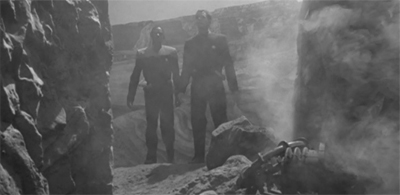
Smoke and mirrors.
At one point, Paris is dramatically reading the telegram from Earth, as an exposition dump in the style of a thirties-era serial. “Intercepted communications between Doctor Chaotica and Arachnia. Stop. Chaotica at war with aliens from Fifth Dimension. Stop. Must strike now to disable Death Ray.” It is a very cheesy moment, indulging the conventions of these types of stories. However, Tuvok very quickly acknowledges how annoying such exposition would be. He cuts across, “Stop. Please summarise the message.”
However, the very best gags in Bride of Chaotica! are the entirely self-aware ones. In the teaser, Kim objects to the sensationalist “last time on Captain Proton!” sequence that does not recall his own memory of events. “We didn’t burst into flames in the last chapter,” Kim protests. “Why are these recaps always so inaccurate?” Many audience members who have sat through misleading trailers or recaps would agree. Paris shrugs it off, “Well, they brought people back to the theatres.”

Lighten the moment.
As the two make their way across the surface of “Planet X”, Kim has more complaints about the story being told. “Planet X looks kind of familiar,” he reflects. It should. The standing set is very clearly “Planet Hell”, the familiar Star Trek planet sets used for rocky surfaces and caves. As the crew recalled in Star Trek: The Next Generation 365:
Paramount calls it “Stage 16.” The TNG call sheets called it “the cave set.” But to the show’s cast and crew, it was… “Planet Hell.”
“I hated Planet Hell with a passion,” Jonathan Frakes says. “It was dirty. It was limiting. It was a horrifying place to work.”
“There was the smell of a tomb about it,” Dan Curry comments. “People would be wheezing by the end of the day.”
The set had been carried over from The Next Generation to Deep Space Nine and Voyager, used in episodes like The Circle, Basics, Part II and Waltz. Kim might be remembering this section of the planet from his adventures with Paris in the appropriately-named Demon.

Out of scope.
As such, the retro science-fiction trappings of Bride of Chaotica! become a way to affectionately and jokingly talk about the conventions of the Star Trek franchise itself. “What was the last place we went to?” Kim asks. “The Mines of Mercury?” Paris suggests. Kim protests, “They’re identical.” Paris shrugs it off. “Sets were expensive.” Still, it is a production reality that is as true in the late nineties as it was in the thirties and forties. The Berman era of Star Trek took itself too seriously to talk about itself in a truly self-aware fashion, so this becomes a roundabout solution.
Indeed, Paris even make a point to demonstrate that the world of Captain Proton! is a funhouse mirror version of the Star Trek universe, build on analogous concepts that just happen to be labelled differently. “Well, we’d have to knock out the Lightning Shield first,” Paris suggests of possible plans to topple Chaotica. Seven suggests, “A forcefield.” Paris is impressed. “Yeah, now you’re catching on.” As Janeway steps into the role of Arachnia, Paris prompts her, “Now remember, it’s ray gun, not phaser. Imagiser, not viewscreen. Earthlings, not Terrans.”
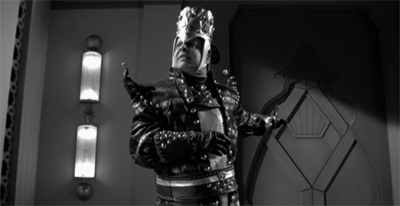
The goon squad.
The fact that such concepts can be mapped one-for-one between the world of Star Trek and the world of Captain Proton! suggests that the two fictional universes share some of the same DNA. Even the photonic aliens in the holodeck simulation evoke the philosophy of the Starfleet crew. “You have invaded my planet,” Chaotica states. “Why?” The aliens respond, “To contact other photonic lifeforms. To learn from them.” Chaotica demands, “Are you alone or are you the vanguard of an invading army?” The aliens reply, “We are explorers.”
The production design of the episode seems to affectionately reference the trappings and aesthetic of the original Star Trek television series, a style of production that had been largely left behind with Encounter at Farpoint. The is most obvious in the construction of Chaotica’s “Fortress of Doom”, which is the kind of matte background design that recalls the establishing shots on the original Star Trek shows; Rigel VII from The Cage, Stratos from The Cloud Minders, Flint’s fortress in Requiem for Methuselah.
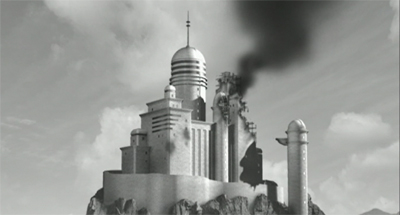
“Do you know how much it costs to insure a Fortress of Doom?”
The costumes and props also reinforce this aesthetic similarity. The “Death Ray” recalls the phaser cannon from The Cage. The “Cradle of Persuasion” looks more like the slabs from episodes like Dagger of the Mind than the restraining tables on The Next Generation, Deep Space Nine or Voyager. Chaotica’s soldiers wear clothe costumes rather than hardened plastic or quilted fabric or stretched leotard; they look similar to the tribal warriors from Friday’s Child or even the original design of the Klingons on Errand of Mercy.
Voyager just happens to be how audiences and producers envisage the future from the perspective of the late nineties. Captain Proton! harks back to the way that audiences used to imagine the future, evoking a vision of the future that is lost to time. Paris’ fascination with the Captain Proton! holoprogram is treated as an act of pop archeology. “I’ve been studying how past generations viewed the future,” Paris offers when asked to explain the program. “Well, it didn’t work out quite as black and white as they imagined.”
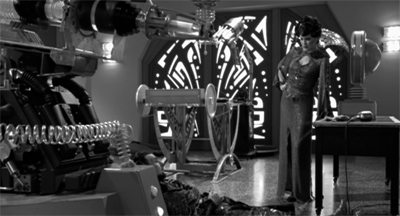
Chaotica reigns!
There is something endearing in this idea that Captain Proton! is an extended metaphor for the larger Star Trek franchise. There will come a time when Deep Space Nine and Voyager look as dated as any of those thirties serials. In fact, given CBS’ refusal to invest the necessary money to update Deep Space Nine and Voyager to high definition, that day might be approaching faster than most fans would like. After all, most studios looking to protect their back libraries have begun a process of upgrading.
As such, Bride of Chaotica! seems optimistic about the potential of shows like Deep Space Nine and Voyager to stand the test of time. There will come a point when audiences will find Deep Space Nine and Voyager just as dated as the original Star Trek in terms of design and production aesthetic – maybe even in terms of politics. However, Bride of Chaotica! seems to suggest that these stories will always have some kind of power, and that they will always be enjoyed or celebrated in one form or another.

Shades of grey.
The move towards high definition and widescreen is arguably a revolution in how television is experienced. There will come a time when standard definition television presented in the classic aspect ratio will be considered in the same way that many modern audience members think of black and white, as a quirky relic of a bygone era. Indeed, it is hard to imagine standard definition ever achieving the same level of cultural cache as black and white, becoming a valid aesthetic choice of itself once it ceases to be the default option.
When that happens, will children want to watch television series in standard definition? Will people begin to brush past shows like Deep Space Nine and Voyager in the Netflix queues, turning their attention to television shows like Friends or Cheers or Maimi Vice that have been properly restored and updated? Bride of Chaotica! has a somewhat positive outlook. The episode seems to suggest that these visions of the future will always be a source of interest and fascination, even when they become outmoded and outdated.

It is not as black-and-white as all that.
It should be noted that Bride of Chaotica! arrived at a point in which the Star Trek franchise was becoming more and more overtly nostalgic. As Duncan Barrett and Michèle Barrett outline in The Human Frontier:
In fact, ever since the thirtieth-anniversary celebrations in 1996, Star Trek had begun to show a pronounced preoccupation with the historical and cultural context from which it sprang – hence the number of episodes that draw on the iconography of mid-twentieth-century America. … [I]t is noticeable that the most popular recurring holoprograms in the later years of both Deep Space Nine and Voyager were Vic Fontaine’s 1962 casino and Tom Paris’ adaptation of a black-and-white sci-fi movie, Bride of Chaotica. Even outside these two recurring programs, the nostalgic appeal of mid-twentieth-century period is heavily emphasised in Paris’s recreations of a 1969 Chevy Camaro (Vis-a-Vis), a 1956 TV set (Memorial), and even an entire cinema in which to screen the 1955 movie Revenge of the Creature (Repression).
It should be noted that Voyager was not alone in feeding this nostalgia. Deep Space Nine had indulged in a two-fer of classic science-fiction nostalgia in Far Beyond the Stars and One Little Ship.
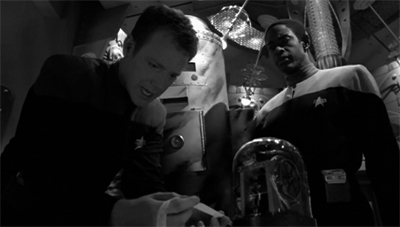
Keeping everything ticking over.
Still, Voyager had felt consciously and overtly nostalgic since it premiered. Its early episodes and season were filled with stories that were more “retro” than those featured on The Next Generation or Deep Space Nine. In fact, Caretaker had established the show in the style of a classic space western that recalled the original Star Trek; there was a new frontier, a desert showdown, the Kazon as awkward racial caricatures, and even a member of the primary cast who had a Native American background.
Voyager reinforced this idea as the season went on. The alien society in Time and Again lacked any make-up and dressed in primary colours, looking like refugees from the original Star Trek series. The Vidiian facilities in Phage and Faces were consciously designed to evoke the horrors conducted by Nazi Germany during the thirties and forties. Jetrel used a metaphor to explore the dropping of the atomic bomb on Japan, while The 37’s featured a pick-up truck floating in the Delta Quadrant.

We’ll always have Paris.
Unfortunately.
There were times in those early years where Voyager seemed eager to embrace the pulpy stylings that had slipped into the background with The Next Generation. (To be fair, the final season of The Next Generation did begin to embrace this approach in the off-the-wall campy adventures like Genesis, Masks and Sub Rosa.) Characters were split and combined in stories like Faces and Tuvix. Old-school metallic robots threatened the crew in Prototype. The show aimed for allegory through broad science-fiction in Innocence. The production team went retro in The Thaw.
Brannon Braga seemed particularly interested with zany trashy sci-fi and horror tropes. Kes unleashed the dark power of her extra-sensory perception in Cold Fire. The EMH developed an evil alternate personality in Darkling. Janeway wrestled with giant flying viruses in Macrocosm. A murder mystery unfolded in an elevator to the sky in Rise. More than that, it seemed like Voyager was still fixated on the atomic bomb. The Omega Directive was a metaphor for nuclear proliferation, while the crew faced literal smart bombs in Dreadnought and Warhead.
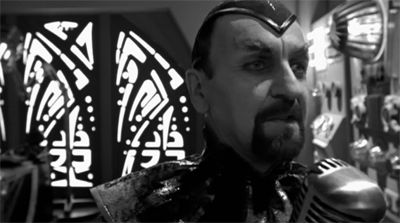
I’m not sure Doctor Chaotica is a fully licensed professional.
However, on the most fundamental level, Voyager was a show that looked backwards. The first three Star Trek shows were all about pushing outwards and expanding the frontier. Kirk broke the galactic barrier in Where No Man Has Gone Before, while Picard reiterated Kirk’s pledge to seek out “new lifeforms and new civilisations.” When Sisko took command of Deep Space Nine, he discovered a gateway to the Gamma Quadrant, which the Federation seemed to keep exploring even after the Dominion told them to mind their own business in The Jem’Hadar.
To be fair, there was a sense that exploration and outward expansion had somewhat stalled in The Next Generation and Deep Space Nine. The frontiers in these shows were not always literal. One of the most iconic moments in The Next Generation comes in The Measure of a Man, with Picard standing in a court room and pointing at Data. “Starfleet was founded to seek out new life; well, there it sits!” Often it seemed like The Next Generation and Deep Space Nine suggested that the final frontiers to be explored were metaphysical rather than literal.

It’s always good to enjoy your work.
Certainly, The Next Generation and Deep Space Nine both made a conscious effort to push the franchise forward and push it in bold new directions. The Next Generation imagined a more thoughtful and intellectual crew than the original Star Trek, one led by a diplomat and archeologist rather than a dynamic adventurer. Deep Space Nine imagined telling long-form and complicated stories within the established framework of the franchise, challenging the idea of what it meant to be Star Trek. The frontier was more abstract, but it was still being pushed.
In contrast, Voyager was a show that was fundamentally about nostalgia. It was about a crew seeking to return to the comforts and securities of home, to the promise of the familiar, and the security of the expected. It was a show about a crew who had found themselves thrown on to the frontier by accident, who were no scrambling desperately for cover. Voyager might not have been literally about the past in the way that First Contact, Enterprise, JJ Abrams’ Star Trek or Discovery might have been, but it represents a point at which the franchise literally retreated into itself.

Ray of light.
The Captain Proton! stories are the ultimate expression of this idea. They embody a sort of retrofuturism. This retrofuturism was not unique to Voyager, instead reflecting a broader trend in popular culture. As Elizabeth Guffey and Kate C. Lemay observed in Retrofuturism and Steampunk:
By the late twentieth century, retrofuturism surged through popular culture, from films to comic books, buildings to television programs, engaging the relationship between the future and the past, as well as broader paradigms such as history, (post)modernity, and progress. it has become the popular futurism of many writers of speculative fiction, as well as a diverse band of scientists, philosophers, and Madison Avenue copywriters who optimistically posited technology-driven change for the future. Today, our futures feel increasingly citational: each is haunted by the “semiotic ghosts” of futures past. For architecture critic Niklas Maak, “Retrofuturism is nothing more than an aesthetic feedback loop recalling a lot belief in progress, the old images of the once radically new.” For others, it has shifted into steampunk, a revisionist take on science fiction. However construed, retrofuturism represents a loss of faith, but it is not a meaningless exercise. Instead, it recycles overlapping material forms of collective memory, reflecting but also challenging ideals, attitudes, and values of what Daniel Rosenberg and Susan Harding have called “the escalating storms of the early 21st century.”
If futurism is a term that describes our anticipation of what is to come, then retrofuturism descrbes how we remember these visions. The term itself is laden with ambiguity, however. where futurism is sometimes called a “science” bent on anticipating what will come, retrofuturism is the remembering of that anticipation.
There is a recurring sense that popular culture has turned its gaze to the past, rather than the future. That audiences can no longer imagine an optimistic future, but instead try desperately to remember what it felt like to imagine a optimistic future. Like the crew of Voyager, audiences seem to want to journey backwards.
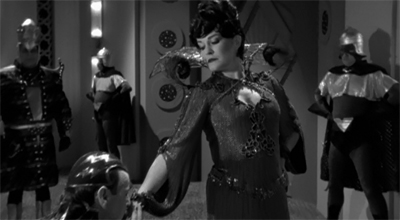
Unbride-led passion.
In some respects, there is no purer example of this than Brad Bird’s Tomorrowland, which opens with the lead character expressing his own nostalgia for a brighter future. “When I was a kid, the future was… different,” reflects Frank Walker on the abundance of apocalyptic imagery in contemporary pop culture. The nostalgic pull of a future of jet packs and rocket ships is understandable, particularly when compared to the dystopias that seem to loom large in the contemporary popular imagination.
Voyager was a very nineties show, informed by the feeling that mankind had run out of history. This is was why time was so malleable in episodes like Timeless and Relativity, why memory was so prone to distortion in Living Witness and Latent Image. In the nineties, as the millennium loomed, there was a sense that the United States stood at the metaphorical end of history. With communism vanquished, with peace and stability, there were no more worlds to conquer and no more major wars to be run. Voyager felt that millennial anxiety to the point that it produced 11:59.
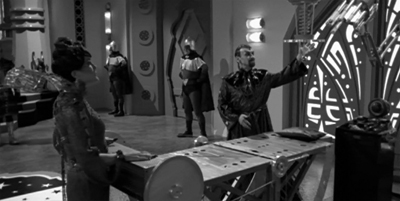
Cradling this new relationship.
This creeping nostalgia had already taken root in popular culture. The remake of Lost in Space had been released less than a year before Bride of Chaotica! was broadcast, another science-fiction franchise going back to its roots. Star Wars: Episode I – The Phantom Menace was less than four months away, a prequel to another beloved franchise. Tim Burton would shortly begin work on his ill-fated remake of Planet of the Apes. The past was in the process of being reclaimed.
Of course, this trend would only heighten in the years that followed. The early years of the twenty-first century saw a conscious nostalgic yearn for the idealism of sixties science-fiction. Stan Lee and Jack Kirby’s work at Marvel Comics came to heavily influence modern blockbusters like The Avengers, but the influence was most overt on X-Men: First Class. The apes got another reboot in Rise of the Planet of the Apes. Christopher Nolan wrote and directed Interstellar as an ode to that sixties pioneering spirit.

This wasn’t part of the brief.
The Star Trek franchise would retreat further and further from the frontier. The later shows and movies would bury themselves within the mythos, return to the origin of the franchise as if trying to discern some meaning that had been lost in the chaos and the shuffle. Rick Berman and Brannon Braga would try to get “back to basics” with Enterprise. Bryan Fuller would move closer to Kirk in Discovery. JJ Abrams would just cut out this dancing around the point and just flat-up recast Kirk and Spock for Star Trek.
It was no small irony that Star Trek seemed incapable of imagining its own future. As audiences retreated into visions of the future rooted in their own past, Star Trek sought comfort in the past of its own future. Bryan Fuller’s original pitch for Discovery was that the show would serve as an anthology series spanning the length and breadth of the Star Trek timeline before pushing boldly into unexplored territory. Unfortunately, this plan proved too ambitious for CBS, who settled on producing a more conventional (and familiar) prequel.
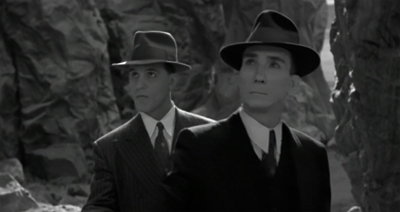
Invades from the fifth dimension, moving backwards through the fourth.
Bride of Chaotica! seems to bring all of this nostalgic yearning to the fore, cementing the thematic nostalgia of Voyager with the literal objective of returning home. Bride of Chaotica! imagines the starship literally stuck in place, its momentum drained as the crew play out a retro science-fiction fantasy. Bride of Chaotica! embraces that nostalgia for a future that no longer exists, a curious nostalgia for the way that audiences used to wish that things would be.
In its own way, there is something grim and funereal lurking behind the stylised black and white imagery, a suggestion that the Star Trek franchise might be as obsolete as its critics were beginning to suggest, that its own optimistic future history might be as outdated as this world of rocket packets and ray guns. Star Trek had been a pioneer for imagining an optimistic and utopian future at a time when such hope seemed impossible. Had the franchise been reduced to a nostalgic curiosity?
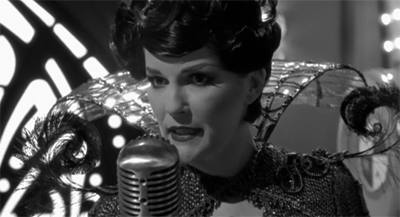
Kiss of the Spider-Queen.
In the closing moments of Bride of Chaotica!, the characters study a screen that plays the closing credits. “The End,” it suggests. However, that text is quickly followed by a question mark. Bride of Chaotica! suggests that the Star Trek franchise might never have to confront its own possible ending so long as it is able to hide in its own past.
Filed under: Voyager | Tagged: arachnia, bride of chaotica!, captain proton!, janeway, nostalgia, retrofuturism, star trek, star trek: voyager |




















The bridge set nearly burned down with Berman inside it? Do you think the universe was trying to tell us something?
I like how McNeill’s version of events kinda hints at this biblical reading. “I don’t know what that was about, but… hey…”
“It was no small irony that Star Trek seemed incapable of imagining its own future. As audiences retreated into visions of the future rooted in their own past, Star Trek sought comfort in the past of its own future.
In its own way, there is something grim and funereal lurking behind the stylized black and white imagery, a suggestion that the Star Trek franchise might be as obsolete as its critics were beginning to suggest, that its own optimistic future history might be as outdated as this world of rocket packets and ray guns. Star Trek had been a pioneer for imagining an optimistic and utopian future at a time when such hope seemed impossible. Had the franchise been reduced to a nostalgic curiosity?”
With the leader of the free world defending Nazis, only calling out their violence with extreme reluctance while attacking the free press without hesitation, the Star Trek future does seem foolishly optimistic. White people outcry they don’t get enough, feminism has been liken to genocidal Nazism, and the free press portrayed as evil. It certainly does seem the future is in retreat. We don’t look to the stars anymore, we don’t even look to the world anymore, and we can only barely tolerate different ideas anymore.
I have no interest in a Star Trek prequel, but I cannot imagine what a modern day optimistic Star Trek future would look like anymore, when the old Star Trek ideals have been thoroughly rejected by the same country that made the show.
I think episodes like Bride of Choatica! will always have an appeal and age very well. It speaks of a more innocent time, when locks weren’t necessary on rocket ships. The old political trappings are so outdated, they do not remain relevant on any level, which gives the episode an almost child-like apolitical naivety. Few could care about what message this episode tries to make because they are ray-guns, doom fortresses and a robot build from a used water heater. And that let’s it just be plain fun.
Oh yeah, it’s definitely fun.
I sound very cynical about Bride of Chaotica!, and I kinda am, but I’m struggling to think of a better run of episodes in the seven years of Voyager than Latent Image, Counterpoint, Gravity and Bride of Chaotica! If that were the show, on loop, I would probably love it as much as I love Deep Space Nine.
It is bizarre. Oddly enough, that maybe gives me a little more interest in a prequel series. One of my big problems with Roddenberry and Berman’s vision was a refusal to acknowledge how exactly this utopia came about, perhaps for fear of offending or provoking audience members. It would have been great to see TNG in its first season make the point that this utopia is built upon the kind of empathy that doesn’t vilify or other same-sex attraction, but instead the show (and the later shows) tend to take that utopian future for granted without acknowledging that mankind has a lot of growing up to do before it can be trusted to build an idealised world.
I think DS9 actually grappled with that question very well, because it understood that people are still people. The characters on Deep Space Nine are more human than any other characters in the franchise, but they try to be good. And it’s hard, and they don’t always succeed, but they try. I think the final two seasons of Enterprise are also underrated in that regard, in that you can literally see the Federation move from being this all-but-certain destined extension of the American Century towards something a lot less certain. In the final two seasons of Enterprise, even though it’s a prequel, it really seems like the Federation is something subversive and bold, and something that will take actual effort to build. (In contrast to the indifference of the first two seasons.)
So I like the idea of a prequel if only because (if it’s done right) it can cover that ground. How did people become better? What lessons did we learn?
My enjoyment of this episode is all about aesthetics. I have long since tired of the “holodeck broken, but can’t be shut down” logical fallacies. Basically any holodeck program, no matter how minor, will inevitably be cannibalized for a plot in Voyager. Although I did appreciate Harry cutting to the chase and asking when they get to ‘meet the slave girls’, which gives you an idea of that these programs would really be about if they existed. I noticed the bondage play with the Delaney sisters as well.
I really enjoy the black and white cinematography, being a photographer who loves shooting monochrome. I also enjoyed the soundtrack, which is better than Voyager’s own wallpaper music in some ways. You can feel the era they’re aiming for – the ambience of Looney Tunes style voice projection and campy Flash Gordon aesthetics.
However, the best part of the entire episode for me might be Chaotica himself. He has one of the best maniacal laughs of all time. I wish I could have sat in the casting room for Chaotica.